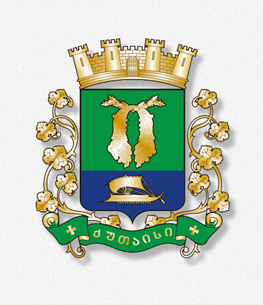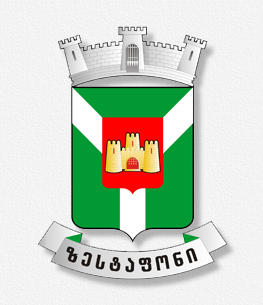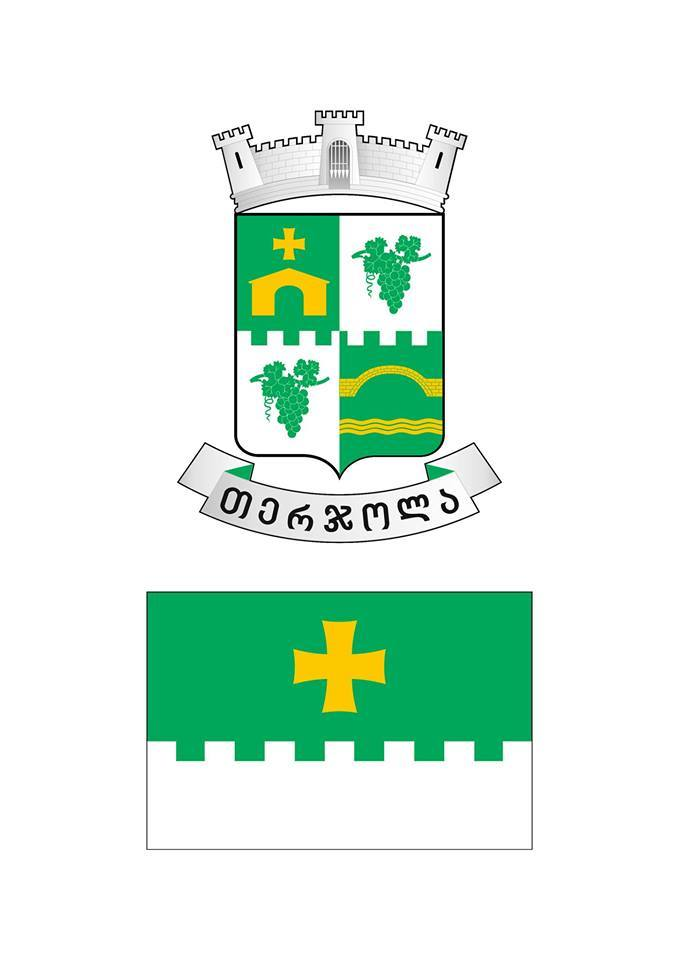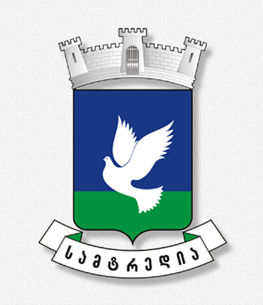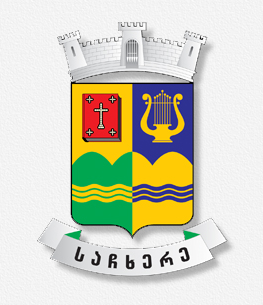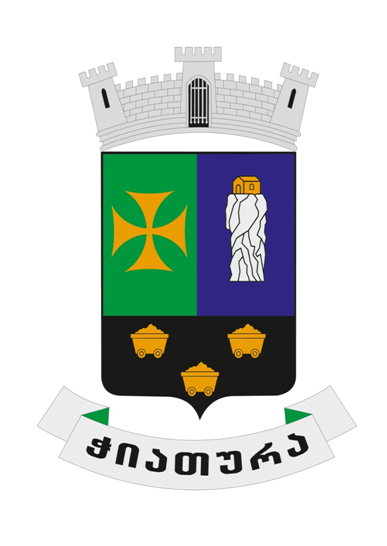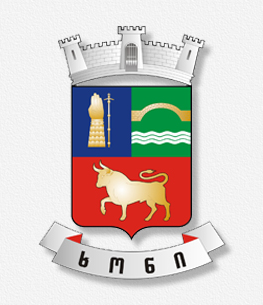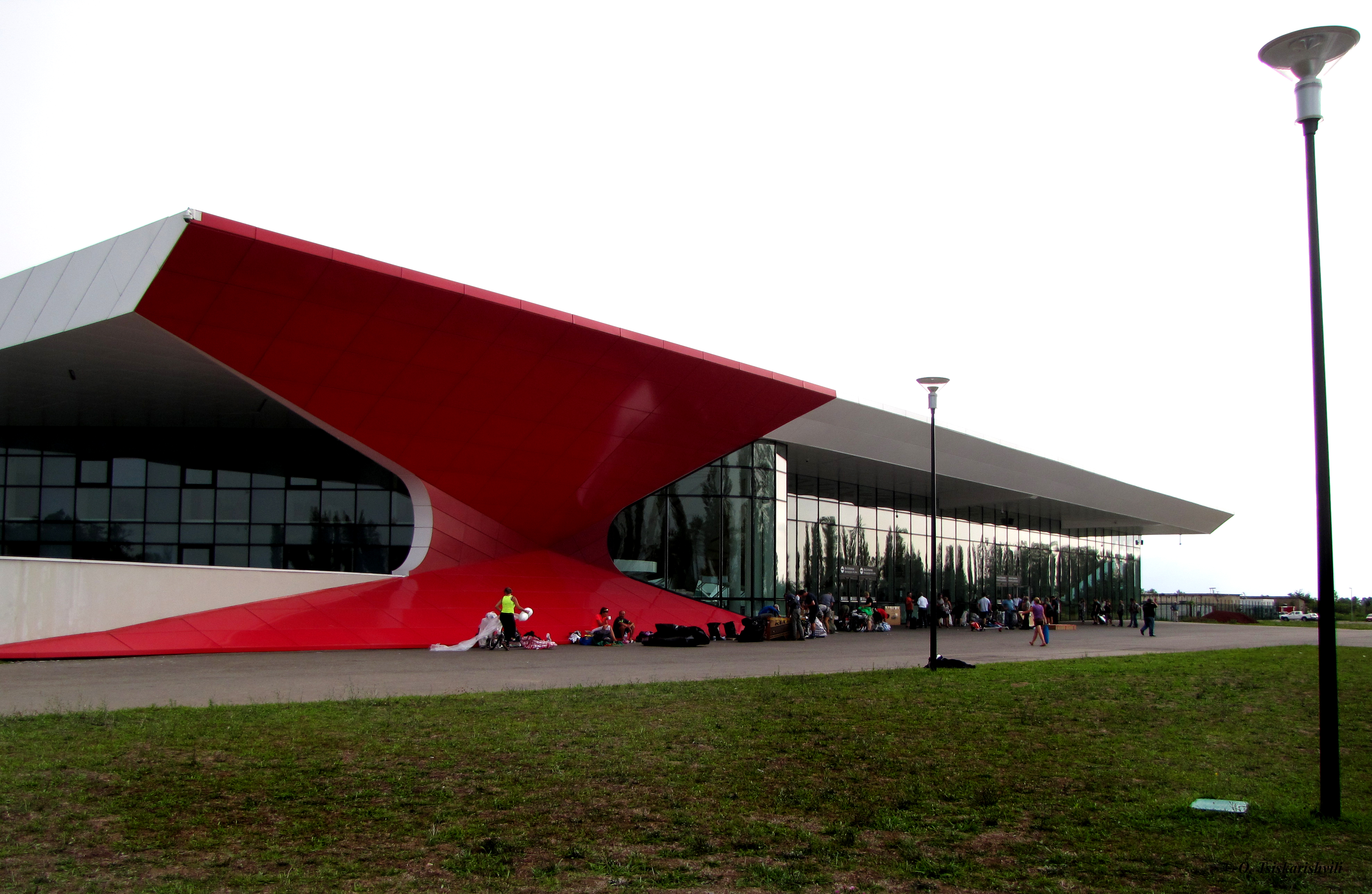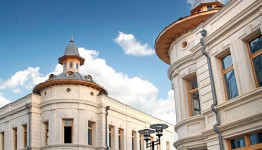KHONI
khoni
- Location
Khoni Municipality geographically is captured between East latitude 42°22' and 42°37'north latitude between 42°14' და 42°35' . The teiritory itself is a north-east continuation of a Kolkheti valley. Its mountainous zone is a south slope of the Egrisi mountain ridge. From lower flow of the left bank of Tskhenistskali river it is spread to the right bank of the Gubistskali river. River Tskhanistskali divides this mountainous zone into two parts. Khoni is bordered by Martvili Municipality in the west, Abasha Municipality in the east-west and Samtredia Municipality in the south, Tskaltubo Municipality in the east and Tsageri Municipality in the north-east.
- Relief
According to relief Khoni municipality is divided into 3 zones: lowland, foothills and also backhill zones . In the lower part it is situated Municipality center –town Khoni and villages: Ivandidi, Qutiri, Gvazauri, Patara Jikhaishi, gubi, Kukhi, Akhalsheni, Kontuati.
Nakhakhulevi, Satsulikidzeo an Mattxoji are situated 62-200m from sea level. Front zone village of the hill : sukhcha, Lepilie, Khidi, Besiauri, Dedalauri, Uzlouri and Akhalbediseuri are situate on 200-500m from sea level and are distinguished by alluvial soils. Mountainous zone villages: Kinchkha, Gordi Ghvedi, Dzedzileti, Gvashtibi, Gelaveri, Oragveti, Nogha and Didghvabuna are situated up to 1000m from sea level.
- Territory
Khoni Territory complies 429.5km2. . Its north part is captured in the mountainous, south belongs to lower zone and covers north- east part of Kolkheti Valley. 58% of municipality is hilly. The lowest place is village Qutiri-62m from sea level and the highest is Lekhi pick-2436.7m from seal level.
Forests covers 20000ha of Khoni territory. Agricultural areas are spread on 18042ha. Among them arable lands are-8020ha, perennials -2251.33ha, hayfields -104ha and pastures-7666 ha.
Khoni municipality from north to south is spread over 42km and its maximum width is 17km and minimum-7.
- Climate
Khoni is situated in humid, subtropical climate zone and according to relief it is characterized by height zonal character. On lowland plains winter is warm and summer is hot with humid subtropical climate characterized by average annual temperature of +14.3°, in January +5°, in August +23.4° ÷ +23.6°; Absolute minimum -18°,-19°, Absolute maximum +41°. On lowland plains average annual precipitation is 1460-1790 mm.
Foothills and lower mountain zone and humid subtropical climate, characterized by small winters and long hot summer. Here, 700 m from sea level the average annual temperature of + 11.7 ° ÷ + 12.4 ° - is within the limits, in January -2.9 ÷ -3.5 °, August + 21 °; The absolute minimum is-21 °, the absolute maximum is+ 38 °.
Precipitation is 2280-2400 mm per year. The average cold winters and long cool summers humid mountainous zone. The same climate region, the highest places-filled plateau, with the difference that the summer is shorter, however, the average rainfall is more abundant in the mountainous area, foothills and lower hilled areas.
- Nature
The mountain area is covered with forests and bushes and its lush valleys, beautiful springs and deciduous forests, mountains and waterfalls with fabulous beauty is the best for tourism and recreation. Especially interesting is Askhi Alpine Mountain (plateau), waterfalls of river Okatse, Okatse Canyon, Tskhenistskali Valley and more.
- Rivers
From the rivers, flowing across Khoni territory most water full is river Tskhenistskali and river Gubistskali. From small rivers it should be noted: Okatse, Nabecho, Ghalda, Metchia, Gharchela, Sukhchela, Kuxa, Semi, Rachkha, Tobi and etc. There are several fish sorts in the river: Barbell, herring, Tof, trout, bullhead and roach fish and etc.
- Spring waters
In the foothill and mountain villages of Khoni there are lots of spring waters. There are old well-known springs among them: Spring of Prince (1832 sec.) and the Queen's spring (XIX c. In Gordi forest- park, little Jikhaishi Ghoghoberidzes Spring (XVI c.), Binuri spring in the village Khidi (Giga’s spring), spring of village of Matkhoji and many more.
- Forests
Total of 20,000 hectares of state forest fund land is within the boundaries of municipality. Mountain micro-zone is covered with deciduous forests and shrubs. It should be noted Kutkhi forest in Kinchha and Turchu forest in Gordi and other forests, where grow oak, lime, chestnut, beech, wild pear, cherry, wildapples, alder, walnut, spruce, pine, acacia, willow, boxwood and other. There is an abundance of berries and medicinal plants. In the forests dwell rabbits, squirrels, wolves, jackals, foxes, bears.
- Historical Past of Khoni
Khoni is a part of hostrical Kolkheti. Its origins and development is closely linked to the routes through trade ways crossing it. Kolkheti land remembers crushing Invasions of ancient Assyria and Urartu Persians and the Romans. People draws a link toRoman commander - Gnaeus Pompey (BC I .)to still preserved ancient bridge - bumbuas bridge. The ruins of the church of St. George are considered to be demolished by Marwan the Deaf invasions. In the nineteenth century, the sixties, Gordon was visited the Russian Emperor Alexander II. He sent the iron bridge later, which served the village until 1985. The remnants of oldest old bridges are still remained in village Nogha, Sukhcha and Dedalauri.
There are found the remains of an ancient metal foundries in Kinchkha, near Tsmidaliani, Akho and Ghvalbajani. Khoni and its villages: Kukhi, Gubi, small Jikhaishi, Qutiri in Nogha , Gordi, Kinchkha and Gvedi there are preserved remains of Middle and Late Bronze Age houses “HILLS” where locals still find bronze military, economic, religious, ritual utensils and copper bars.
In Kinchha it is found antiquity gold coin, King akis (c. Sec. III century
King of Colkhis) stater, the ballot was "Colkhian tetri" 1270 pieces of coins, Byzantine and Turkish coins, which tells us about developed market economies of that time. Until Middle ages Khoni was included in the King’s domain. The churches in Khoni nearby villages should have been built in the first centuries of the christianity : In Khoni –church named after saint Stephen, 14 churches named after St. George and a small chapel in church named after St. Marineri in Gelaveri, Tareshi in KInchkha, Obuji in Khidi.
Very interesting monuments of Christian architecture are currently located in the area eparchy. Khoni St. George cathedral church built in the end of the VIII century. Municipality center Khoni town belongs to those small towns of West Georgia which were emerged and mostly developed in the second half of XIX centuries. Town Khoni was founded around the Church of Saint George.
In 1529 Khoni became center of Episcopacy which supported its territorial growth and industrial-economical rise. In XVIII Khoni represented an important trade spot with merchandise links in South and North Caucasia, South Russia.
Imereti Kingdom occupation by Russian and during the Russian reign, Khoni became Vake District center. Since 1846, after establishment of Kutaisi Province, Khoni was included in Kutaisi province. Since 70s, it was a police discrict center. In 20-30s of 19th century Khoni was a densely populate spot. In 50s a tobacco trade market was opened here. Besides tobacco, here was sold agricultural products and other handmade materials. After peasants’ reform economics of Khoni was rapidly developing. Khoni was competeing with Samtredia town though it was done a railway I 18th km from Khoni to Smatredia. This can be firstly explained by well developed agriculture, workmanship, handmade production, trading. They were supplied with goods from big industrial Centers of Russia, Europe and America. In 70s of 19th century Khoni was the most important trading and industrial center after Kutaisi in Imereti. Here were timber and textile plants working on water engines, brick and tile plants, tens of handmade workshops and smitheries. Sericulture industry was escalating. Khoni became the wide center for silk production.Khoni market, arranged on Friday, was famous from Feudal Age not only in Georgia but also in whole Transcaucasia.
In 1982, by initiative of N.Nikoladze, N.Tsereteli, I.Sharashidze and others there was made a channel from river Tskhenistskali in Khoni –Jikhaishi direction. This channel was used to irrigate 12 thousand acre of area. Khoni town was officially admitted after the February revolution of 1917. Khoni population was always actively evolved in social and public political life of the country.
Historically, it was one of the cultural-educational center of west Georgia. In the secondhalf of 19th century here were different learning establishments, among them famous (not only in Georgia) Teachers’ Seminary.
Khoni is a town of theatrical traditions. The 1st theatrical performance was staged in 1865. In 1907 here was founded a small theatrical group.
Khoni ‘s orchestra founded in 1890, was the very first one in West Georgia to appear. The orchestra soon became very popular in whole Imereti.
Many famous people were brought up in Khoni. They played significant role in Georgian culture and science. They are: Poets and writers: Irakli Abashidze, Polikarpe Kakabadze, Mariam Garikuli (Tateishvili); painters: Davit Kakabadze, Apolon Kutateladze, Korneli Sanadze; film producers: Davit Rondeli (Tsagareishvili), Vladimer Karsanidze, Shalva Chagunava, Nana Mchedlidze. Famous art critic, academic: Vakhtang Beridze, cybernetic :Vladimer Tchavtchanidze, Academic: pharmacologist Iovel Kutateladze, linguist: Shota Dzidziguri, conductor: Zaqaria Khurodze, actors: Ipolite Khvichia, Guram Sagharadze and others.
- Natural monuments. :
Gorge of River Tskhenistskali.
Gorge of River Tskhenistskali.
Alpine Zone of Askhi Mountain.
River Okatse Canyon.
Carstic caves on Askhi mountain in the Tobi river basin.
Daiani forest-park in the village Gordi.
Gordi Cave
Tsmindaliani Cave“ in Kinchkha.
Turchu Mountain caves
Kldeida Cave at the borer of Gordi and Kinchkha.
Ggvalbajiani Cave at the border of Kinchkha-Ghvedi border
Qvabikari Cave in Ghvedi.
Tchirkari Cave in Matkhoji
Satevzia Cave in Dzedzileti.
- Historical Monuments, Churches and Monasteries.
Khoni town:
Khoni Samtredia eparchy residency (1996), 1181-former Teachers; Seminary
„Saint George Church“, VIII-XI century
Village Matkhoji:
„Saint Basili Church:, 1864
„Saint Nino Nuns’ Monastery“, 1872
Matkhoji fortress, Ancient age
Village Khidi:
Obuji Church remnants, middle century
„Bumbua“ Pompous bridge 65 BC.
Village Suchkhe:
Mother Maraimi Church, middle age
Village Gordi:
Rekhi fotress in Didghvabuna, late middle ages.
Dadianis country seat, 1806
Bangveti church, X-XI century
Veli fortress XVIII century
Archangel Church, XIX century
Davit Dadiani spring, XIX century
Queen’s Spring, XIX century
Dadiani forest-park, XIX century
Dadianis country seat church after saint George , XVIII century
Village Nogha:
Nogha church, late middle age
Nogha „Uqimerioni“, middle age
Village Kinchkha:
Oldest chapel – sacrificial , Cross-type sarcophagus in the tomb, the centuries-old Yew trees
Saviour Church, the late Middle Age
Tareshi chrch and burial vault , middle age
City remains, middle century
Village Dzedzileti :
Archangel church
Gvishtibi church, XVII century
Gvashtibi fortress , XVII century
Village Gelaveri:
Marine Church , XVIII century
Village Gvedi:
Ghvedi tower,
Village Qutiri:
Siant George church, 1872
Village Small Jikhaishi:
Saviour Church, 1897
Siant George Church, 1790
Village Satsulukidzeo:
Kvirike and Ivlita church remains, XIX
Village Akhalbediseuli:
Udzlouri Saviour Church, 1319
Village Akhalesheni :
Namashevi fortsress MUkhurisi, Mimddle age
Akhalsheni Catholic Church , 2005
Village Kukhi:
Saint Nikolozi church in Small Kukhi, 2005
Village Nakhakhulevi:
„Saint Barbara “ Church, 2005
Village Ivandidi:
church after Ioane godfather, 2005
- Administrative entities; population
There are 12 administrative units in Khoni Municipality: Khoni town, Gordi Community, village Gocha Jikhaishi, Gibis Community, Dedalarui community, Village Ivandidi, Kinchki community, Matkhoji community, Nakhakhulevi community Qutiri community and Dzedzileti Community.
- Khoni town
Khoni is one of the outstanding and vivid towns of west Georgia. It has always been playing a significant role in the social-economic political and cultural life.
Khoni is situated in lower Imereti, at the bank of Gubistskali and Tskhenistkali affluents of Rioni river. It is situated 266km from Tbilisi city, 28km from Kutaisi city, 19km from Samtredia town, 15km from Tskaltubo town, 15km from Martvili town.
Khoni geographical location is determined by the following data: latitude 42°14' and 42°35', height from sea level is 114 m. The climate is humid subtropical. Winter is mild with average annual temperature +14,3°, annual number of precipitation -1790 mm.
From material-cultural monuments of Khoni it is worse to note saint George church (8th century) -a big sized basilica, three nave basilica type of church without a dome. It consists of Khoni –Samtredia Eparchy.
In the center of the town near Saint George church there is Khoni-Samtredia eparchy residence (in 1996 Khoni returned back its church function-Khoni eparchy has been revived).
Khoni is bejeweled by 19th century developed Boulevard, where the fall of exotic plants and the best recreational place make Khoni locals and city visitors happy.
You can get complete information on the renewed historic museum of Khoni about the city and historical past whole Khoni municipality.
The city is rich with main and children's libraries full with wide variety of literature. Four newspapers are being issued: "Khoni", "Taoba", "Tanadgoma", “Atinati”and a TV station “Mega TV”.
Khoni has always been considered as an important cradle of education and culture in West Georgia. There are four public schools, one gymnasium, three kindergartens in the town nowadays..
A theater group, orchestra, folklore ensemble, puppet theatre operate in the town together with music and art schools, song and dance ensembles with rich past traditions.
There are sport school, basketball and wrestling gy,s, football stadium and mini stadium.
Town’s healthcare is served by health care facilities and emergency service existed in the city.
Town is supplied by drinking water from village Matkhoji water reservoir.
Lately a lot of things has been done for the city's infrastructure and amenities.
On Wednesdays and wundays are still being held a large market days (In 18th century Khoni was an important trade spot).
- Tradition
“Giorgoba” was a traditional festival for Khoni population which used to take place un May 6 of Spring and November 23 of Autumn. Whole Imereti residents use to gather for this festival. The festival was attended by kings and its noble men. “Giorgoba” festival held in Khoni and Ilori w as outstanding with its magnificence. (right arm of Saint George in buried in Khoni, left arm is in Ilori). The famous publicist Ilia Khoneli wrote: “for Lower Imereti peasant this was a magnificent festival and nothing could compare to it in the whole world. This was not only religious festival but also accompanied with variety of spectacular performances like different sport and creative events.
Since 1998 annually on May 6, on festival “Giorgoba” another public event “Khoneloba” takes place. After the celebrating liturgy many amazing events are held like public stroll in Khoni Boulevard accompanied by famous orchestra’ honorary Khoni citizen is nominated an many, many other events. This day Khoni has many famous visitors, especially those, who live outside Khoni and hurry to native town to celebrate the festival.
- Friend towns.
In 1998 friendship memo was signed between Khoni town, Georgia and Elista town, Kalmyke.
In 2008 friendship memo was signed between Khoni town, Georgia and Boski Sant Anna, Verona, Italy town, Kalmyke.
- Tourism Potential of Khoni
Tourism potential of Khoni, like natural monuments and historical attractions make a good perspective for different types of tourism development. Interesting tourism attractions are:
- River Tskhenistskali Gorge
Gorge of River Tskhenistskali reached Black sea by one top of the big silkroad through Kutaisi, Khoni, Bumbua bridge and Naqalaqevi. Its one branch was the road of river Tskhenistskali torwards Racha-Lechkhumi and lower Svaneti. (1272 coins of antique age is found close to Khoni , along this road). This important strategic inner road was specially strengthened with fortresses by our ancestors: Unagira (in Khuntsi), Matkhoji fortress, Didghvabuni or lower Gordi fortress, Rekhi fortress, Veli and Metchii fortresses.On the left side of the river there is a Gvashtabi fortress and many other fortresses are dispersed in this area.
The river gorge and historical monuments existed there in this gorge are important from tourism point of view. River Tskhenistkali is very also for small kayaks boating from its beginning until its mouth. The river was used for the same purpose before.
- Askha Mountain
The slopes of a subalpine massive up to 1800meter from seal level, are covered by coniferous forests. Its smoothed hillocks are used for summer pastures, the highest of which –Lekhi is 2449meter long. This part of massive is covered by snow until the first part of June month and can be compared with Gudauri and Bakuriani skiing resorts by its natural conditions. It is 50kilometrs from Kutaisi.
As for Askhi Mountain, it is very perspective by speleological point of view as it is rich with carst caves.
17 caves were discovered in a few kilometers from river Tobi basin, which is full of many stalactites, natural columns. Some of the caves in the bottom have flowing ground water, which the stand as the most beautiful waterfalls above the ground. The caves are connected with a complex system of tunnels with each other and its approximate length reaches to 15 kilometers.
- Canyon of river Okatse
Okatse river flows from Askhi mountain. Its ancient-more than million years old and beautiful canyon is 16metrs long, width in some areas is 10-15 meters long, depth is more than 50 meters. There can be find natural stone bridges (“Stonebridge”). One of them is called a “Boga”, under which the depth of the canyon layer reaches 100meters. The canyon has carst caves from where carst waters are flowing out. Okatse canyon in tectonic fault. The river forms a multi-waterfall, the largest of which is 80 meters, and lakes, whose clear blue-green water is reflected in the white bottom. River Okatse, in Gorda section is arranged by hanging paths, which allows the river landscape to look more browsing. From Visitor’s cabin, path goes through Forest Park, where the ruins of the palace and the church of Dadianis attract our attention.
There are hung paths on the river Okatse area, which enables visitors to look around the landscape. From visitors’ areas, path crosses the Dadiani forest-park where one can see remnants of the palace and look around Dadiani palace church.
- Park covers 50 ha land area
The last chief of Samegrelo region David Dadiani (before 1923 Gordi-Kinchha was included in Senaki district), his wife Catherine Chavchavadze started considerable architectural construction works in 40th of 19th century in this area. Two magnificent palaces were built by Vasilievi architect project. One of them was burnt by rebelled Social Democrats in 1905 (currently second on is also ruined). 15 ha is occupied by a beautiful garden with alleys, church, springs and Swan lake built by foreign decorators.
- Kibula
Kibula is a valley “fenced” by massive rock and sloped down to the west. In the village Kinchkha, where there are here and there artificial layers heightened fortress gate “ Mamukaskari”. here we can find huge remnants of the Hall: “Nadarbazevi”. The north side is strengthened by enormous stone fence. It is still endured clay pipes of the canalization system. Visitors are surprised by seeing the hugeness of the stones of the stone fence.
- Tareshi
Tareshi is the important historical monument in the village Kinchkha. It is the remains of the sublimity of the pagan area, where Christians had left three yew-trees on the name of the holy trinity, having the other ones cut down. One of them is standing. It is the most aged tree in Georgia. There is a spring there and the remains of the oldest church. Also there is a oval built arched semi circled form burial vault (VI-VIII).
- Khocholi
Khocholi is the iron age oldest hill-settlement, where iron fighting weapons and etc was found (these monuments of Kinchkhi is situated closer to the road).
- Satevzia Carst Cave
Satevzia Carst Cave is situated on the left bank of the river Tskhenisktskali, in the village Dzedzileti. It is 7kilometers from “Prometheus” cave (Village Kumistavi, Tskaltubi Municipality).
In 70-80s of last, Speleologists and medics studied the cave and ascertainment its iniquity as a natural monument as well as from medical point of view. In the cave halls there are many stalactites, stalagmites, lakes and etc. “Satevzia” cave requires its thorough studies and tourism infrastructure arranging which will confer it on a status of an important tourism spot.
It should be noted that the cave is situated near Okatse Cave which’s infrastructural arrangements has been started.
- Khoni Cathedral
Khoni Cathedral after Saint George (VIII century) is a three nave basilica type of church without a dome. It is built by modest, white carved stones. It makes one admire to see the cathedral paintings. There are some historic captions and frescos. From preserved deliquesces of the Khone cathedral outstanding is a big miraculous icon after Saint George, which makes art-critics admired.
The left arm of Saint George is buried in Khoni (the left one is in Ilori).
Since 1996, after restoration of the Eparchy again, Saint George Church becomes the Cathedral of Khoni-Samtredia Eparchy.
- Museums
Khoni Historic Museum is located in the city center, d. Guramishvili Street. №3-in. The museum houses dozens of unique monuments, manuscripts and documents. It should be noted three treasures of Kholkhis Tetra, engraved art, bronze and iron-era monuments, rich grave inventory and excellent ethnographical items. There are also theological books survive by museum, Holy Bibles, icons, crosses. Prehistory, the Bronze and Early Iron Ages, feudal era, IX-XX centuries are presented in four large exhibition halls of the Museum. The last hall display life characteristic materials of Khoni area, as well as the countryside Industry. Visitors have the opportunity to obtain comprehensive information on the city and the historical past of the Khoni district and famous Khoni residents.
The museum has three departments: the Museum of Military Glory, Polikarpe Kakabadze and Irakli Abashidze memorials.
- Khoni Historical Museum
Khoni Museum of Military Glory is situates on the second floor of the museum building. The museum has 6 exposition halls an 4 rooms. Here is represented Khoni residents participation in the second world war. Around 7000 Khoni residents participated in the war and 4000 from which died in the battlefield. Four of them were awarded as heroes. in the National Hall of the museum it is well laid out bravery and devotion of patriots who sacrificed themselves for thefreedom, independence of Georgia and unity: in Abkhazia, South Ossetia and against Russian aggression in August 2008.
- Museum of Irakli Abashidze
In Khoni town, Abashidze street it is situated a museum of Irakli Abashidze. Here a visitor can get aquanted with the childhood and youth of the writer, his patriotic poetry, contribution in publishing of Georgian Enciclopedia. One can see his personal belongings, notes and etc.
- Museum of Polikarpe Kakabadze
The museum of Famous Georgian dramatist and public figure, Poilikarpe Kakabadze is located in 2km from Khoni in the village Patara Kukhi. According to the materials, like works, private things preserved in the museum, visitor can better recognize the biography and creations of the writer.
Video
News calendar
 |
July 2024 |  |
||||
|---|---|---|---|---|---|---|
| Mon | Tue | Wed | Thu | Fri | Sat | Sun |
| 1 | 2 | 3 | 4 | 5 | 6 | 7 |
| 8 | 9 | 10 | 11 | 12 | 13 | 14 |
| 15 | 16 | 17 | 18 | 19 | 20 | 21 |
| 22 | 23 | 24 | 25 | 26 | 27 | 28 |
| 29 | 30 | 31 | ||||
Calendar




